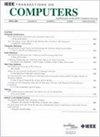A High-Efficiency Parallel Mechanism for Canonical Polyadic Decomposition on Heterogeneous Computing Platform
IF 3.8
2区 计算机科学
Q2 COMPUTER SCIENCE, HARDWARE & ARCHITECTURE
引用次数: 0
Abstract
Canonical Polyadic decomposition (CPD) obtains the low-rank approximation for high-order multidimensional tensors through the summation of a sequence of rank-one tensors, greatly reducing storage and computation overhead. It is increasingly being used in the lightweight design of artificial intelligence and big data processing. The existing CPD technology exhibits inherent limitations in simultaneously achieving high accuracy and high efficiency. In this paper, a heterogeneous computing method for CPD is proposed to optimize computing efficiency with guaranteed convergence accuracy. Specifically, a quasi-convex decomposition loss function is constructed and the extreme points of the Kruskal matrix rows have been solved. Further, the massively parallelized operators in the algorithm are extracted, a software-hardware integrated scheduling method is designed, and the deployment of CPD on heterogeneous computing platforms is achieved. Finally, the memory access strategy is optimized to improve memory access efficiency. We tested the algorithm on real-world and synthetic sparse tensor datasets, numerical experimental results show that compared with the state-of-the-art method, the proposed method has a higher convergence accuracy and computing efficiency. Compared to the standard CPD parallel library, the method achieves efficiency improvements of tens to hundreds of times while maintaining the same accuracy.异构计算平台上标准多元分解的高效并行机制
正则多元分解(CPD)通过对一阶张量序列求和得到高阶多维张量的低秩逼近,大大减少了存储和计算开销。它越来越多地应用于人工智能的轻量化设计和大数据处理。现有的CPD技术在同时实现高精度和高效率方面存在固有的局限性。为了在保证收敛精度的前提下优化计算效率,提出了一种异构计算方法。具体而言,构造了拟凸分解损失函数,求解了Kruskal矩阵行极值点。进一步提取算法中大规模并行化的运算符,设计软硬件集成调度方法,实现了CPD在异构计算平台上的部署。最后,对存储器访问策略进行优化,以提高存储器访问效率。在实际稀疏张量数据集和合成稀疏张量数据集上对算法进行了测试,数值实验结果表明,与现有方法相比,本文提出的算法具有更高的收敛精度和计算效率。与标准CPD并行库相比,该方法在保持相同精度的情况下,效率提高了数十倍至数百倍。
本文章由计算机程序翻译,如有差异,请以英文原文为准。
求助全文
约1分钟内获得全文
求助全文
来源期刊

IEEE Transactions on Computers
工程技术-工程:电子与电气
CiteScore
6.60
自引率
5.40%
发文量
199
审稿时长
6.0 months
期刊介绍:
The IEEE Transactions on Computers is a monthly publication with a wide distribution to researchers, developers, technical managers, and educators in the computer field. It publishes papers on research in areas of current interest to the readers. These areas include, but are not limited to, the following: a) computer organizations and architectures; b) operating systems, software systems, and communication protocols; c) real-time systems and embedded systems; d) digital devices, computer components, and interconnection networks; e) specification, design, prototyping, and testing methods and tools; f) performance, fault tolerance, reliability, security, and testability; g) case studies and experimental and theoretical evaluations; and h) new and important applications and trends.
 求助内容:
求助内容: 应助结果提醒方式:
应助结果提醒方式:


